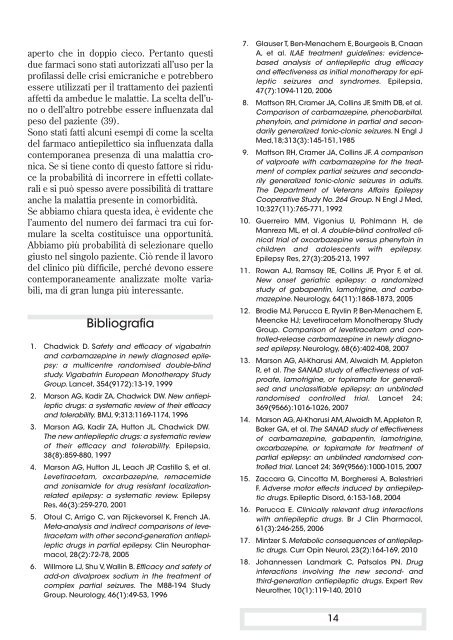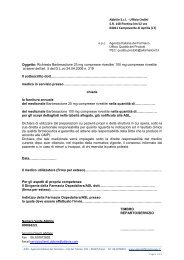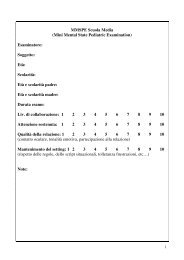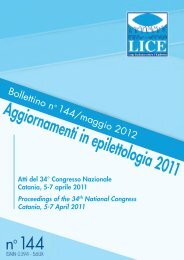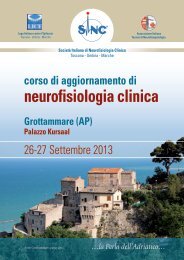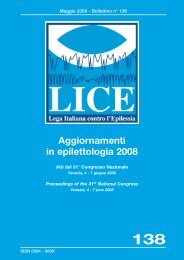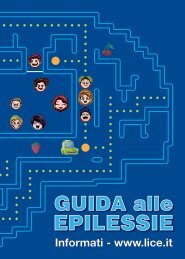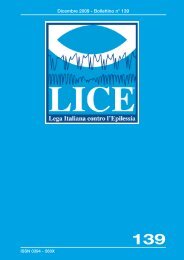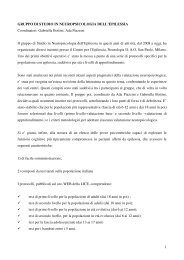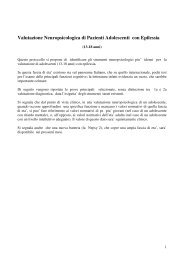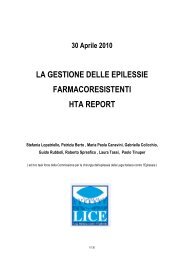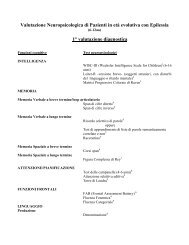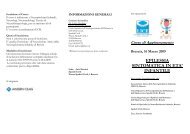Create successful ePaper yourself
Turn your PDF publications into a flip-book with our unique Google optimized e-Paper software.
aperto che in doppio cieco. Pertanto questi<br />
due farmaci sono stati autorizzati all’uso per la<br />
profilassi delle crisi emicraniche e potrebbero<br />
essere utilizzati per il trattamento dei pazienti<br />
affetti da ambedue le malattie. La scelta dell’uno<br />
o dell’altro potrebbe essere influenzata dal<br />
peso del paziente (39).<br />
Sono stati fatti alcuni esempi di come la scelta<br />
del farmaco antiepilettico sia influenzata dalla<br />
contemporanea presenza di una malattia cronica.<br />
Se si tiene conto di questo fattore si riduce<br />
la probabilità di incorrere in effetti collaterali<br />
e si può spesso avere possibilità di trattare<br />
anche la malattia presente in comorbidità.<br />
Se abbiamo chiara questa idea, è evidente che<br />
l’aumento del numero dei farmaci tra cui formulare<br />
la scelta costituisce una opportunità.<br />
Abbiamo più probabilità di selezionare quello<br />
giusto nel singolo paziente. Ciò rende il lavoro<br />
del clinico più difficile, perché devono essere<br />
contemporaneamente analizzate molte variabili,<br />
ma di gran lunga più interessante.<br />
Bibliografia<br />
1. Chadwick D. Safety and efficacy of vigabatrin<br />
and carbamazepine in newly diagnosed epilepsy:<br />
a multicentre randomised double-blind<br />
study. Vigabatrin European Monotherapy Study<br />
Group. Lancet, 354(9172):13-19, 1999<br />
2. Marson AG, Kadir ZA, Chadwick DW. New antiepileptic<br />
drugs: a systematic review of their efficacy<br />
and tolerability. BMJ, 9;313:1169-1174, 1996<br />
3. Marson AG, Kadir ZA, Hutton JL, Chadwick DW.<br />
The new antiepileptic drugs: a systematic review<br />
of their efficacy and tolerability. Epilepsia,<br />
38(8):859-880, 1997<br />
4. Marson AG, Hutton JL, Leach JP, Castillo S, et al.<br />
Levetiracetam, oxcarbazepine, remacemide<br />
and zonisamide for drug resistant localizationrelated<br />
epilepsy: a systematic review. Epilepsy<br />
Res, 46(3):259-270, 2001<br />
5. Otoul C, Arrigo C, van Rijckevorsel K, French JA.<br />
Meta-analysis and indirect comparisons of levetiracetam<br />
with other second-generation antiepileptic<br />
drugs in partial epilepsy. Clin Neuropharmacol,<br />
28(2):72-78, 2005<br />
6. Willmore LJ, Shu V, Wallin B. Efficacy and safety of<br />
add-on divalproex sodium in the treatment of<br />
complex partial seizures. The M88-194 Study<br />
Group. Neurology, 46(1):49-53, 1996<br />
7. Glauser T, Ben-Menachem E, Bourgeois B, Cnaan<br />
A, et al. ILAE treatment guidelines: evidencebased<br />
analysis of antiepileptic drug efficacy<br />
and effectiveness as initial monotherapy for epileptic<br />
seizures and syndromes.<br />
47(7):1094-1120, 2006<br />
Epilepsia,<br />
8. Mattson RH, Cramer JA, Collins JF, Smith DB, et al.<br />
Comparison of carbamazepine, phenobarbital,<br />
phenytoin, and primidone in partial and secondarily<br />
generalized tonic-clonic seizures. N Engl J<br />
Med,18;313(3):145-151,1985<br />
9. Mattson RH, Cramer JA, Collins JF. A comparison<br />
of valproate with carbamazepine for the treatment<br />
of complex partial seizures and secondarily<br />
generalized tonic-clonic seizures in adults.<br />
The Department of Veterans Affairs Epilepsy<br />
Cooperative Study No. 264 Group. N Engl J Med,<br />
10;327(11):765-771, 1992<br />
10. Guerreiro MM, Vigonius U, Pohlmann H, de<br />
Manreza ML, et al. A double-blind controlled clinical<br />
trial of oxcarbazepine versus phenytoin in<br />
children and adolescents with epilepsy.<br />
11.<br />
Epilepsy Res, 27(3):205-213, 1997<br />
Rowan AJ, Ramsay RE, Collins JF, Pryor F, et al.<br />
New onset geriatric epilepsy: a randomized<br />
study of gabapentin, lamotrigine, and carbamazepine.<br />
Neurology, 64(11):1868-1873, 2005<br />
12. Brodie MJ, Perucca E, Ryvlin P, Ben-Menachem E,<br />
Meencke HJ; Levetiracetam Monotherapy Study<br />
Group. Comparison of levetiracetam and controlled-release<br />
carbamazepine in newly diagnosed<br />
epilepsy. Neurology, 68(6):402-408, 2007<br />
13. Marson AG, Al-Kharusi AM, Alwaidh M, Appleton<br />
R, et al. The SANAD study of effectiveness of valproate,<br />
lamotrigine, or topiramate for generalised<br />
and unclassifiable epilepsy: an unblinded<br />
randomised controlled trial. Lancet 24;<br />
14.<br />
369(9566):1016-1026, 2007<br />
Marson AG, Al-Kharusi AM, Alwaidh M, Appleton R,<br />
Baker GA, et al. The SANAD study of effectiveness<br />
of carbamazepine, gabapentin, lamotrigine,<br />
oxcarbazepine, or topiramate for treatment of<br />
partial epilepsy: an unblinded randomised controlled<br />
trial. Lancet 24; 369(9566):1000-1015, 2007<br />
15. Zaccara G, Cincotta M, Borgheresi A, Balestrieri<br />
F. Adverse motor effects induced by antiepileptic<br />
drugs. Epileptic Disord, 6:153-168, 2004<br />
16. Perucca E. Clinically relevant drug interactions<br />
with antiepileptic drugs. Br J Clin Pharmacol,<br />
61(3):246-255, 2006<br />
17. Mintzer S. Metabolic consequences of antiepileptic<br />
drugs. Curr Opin Neurol, 23(2):164-169, 2010<br />
18. Johannessen Landmark C, Patsalos PN. Drug<br />
interactions involving the new second- and<br />
third-generation antiepileptic drugs. Expert Rev<br />
Neurother, 10(1):119-140, 2010<br />
14


